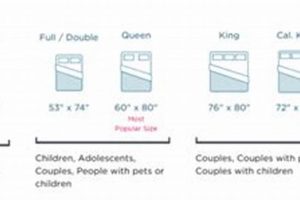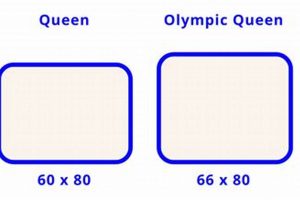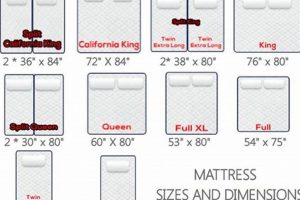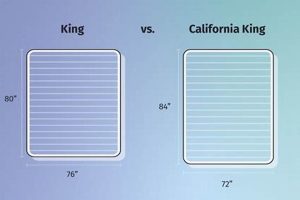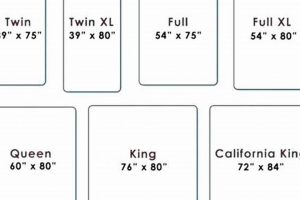The measurement specifications of a mattress intended for use on a bunk bed frame are critical for safety and functionality. These measurements, typically expressed in inches or centimeters, define the length, width, and thickness of the sleeping surface. For example, a standard twin-size mattress designed for a bunk bed often measures approximately 75 inches long and 39 inches wide, with a thickness that varies depending on the design but usually does not exceed 8 inches to comply with safety regulations.
Adherence to specified measurements ensures compatibility with the bunk bed frame, preventing slippage and reducing the risk of falls. Furthermore, correct sizing optimizes the available headroom for the occupant of the lower bunk and maintains the structural integrity of the overall bed unit. Historically, variations in mattress sizes presented significant safety concerns, leading to the establishment of standardized guidelines to promote safer sleep environments, particularly in shared living spaces.
A thorough understanding of mattress sizing is fundamental when selecting appropriate bedding for bunk beds. The subsequent sections will delve into specific size variations, safety standards, and considerations for choosing the ideal mattress thickness to meet both comfort and safety requirements.
Bunk Mattress Selection Guide
The following provides essential guidance for choosing mattresses intended for bunk bed use. Adherence to these recommendations promotes safety, comfort, and longevity of the sleeping arrangement.
Tip 1: Prioritize Safety Standards: Confirm that any mattress selected complies with relevant safety regulations, including maximum thickness limitations to prevent exceeding the height of bunk bed guardrails. Failure to do so can increase the risk of falls.
Tip 2: Verify Precise Measurement Compatibility: Before purchase, meticulously measure the interior dimensions of the bunk bed frame. The mattress should fit snugly, minimizing gaps that could pose a safety hazard.
Tip 3: Consider Occupant Weight Capacity: Evaluate the weight-bearing capacity of both the bunk bed frame and the mattress itself. Select a mattress designed to adequately support the intended users weight, ensuring structural integrity and preventing premature wear.
Tip 4: Optimize Thickness for Headroom: Carefully assess the thickness of the mattress in relation to the height of the lower bunk. Choose a mattress that allows adequate headroom for occupants of the lower bunk while still providing sufficient support and comfort.
Tip 5: Explore Material Options for Durability: Evaluate different mattress materials, such as foam, innerspring, or hybrid constructions, based on their durability and suitability for bunk bed use. Opt for materials known for resistance to compression and wear.
Tip 6: Review Warranty and Return Policies: Scrutinize the manufacturer’s warranty and return policies before making a purchase. This ensures recourse in the event of defects or incompatibility with the bunk bed frame.
Following these guidelines contributes to a safer and more comfortable sleep environment. Prioritizing accurate measurements, safety compliance, and durable materials is paramount when selecting mattresses for bunk beds.
The subsequent section will address frequently asked questions regarding bunk mattress dimensions and associated considerations.
1. Thickness Limitations
Thickness limitations are a critical consideration within bunk mattress parameters. These restrictions are primarily governed by safety standards designed to mitigate the risk of falls from the upper bunk. The available distance between the top of the mattress and the upper edge of the guardrail dictates the maximum permissible thickness. Exceeding this limit compromises the effectiveness of the guardrail, increasing the potential for injury.
- Guardrail Height and Protrusion
The height of the guardrail above the sleeping surface is directly influenced by mattress thickness. Safety regulations mandate a minimum guardrail height to prevent occupants from rolling out of bed. If the mattress is too thick, it reduces the effective guardrail height, potentially rendering the bed unsafe. Manufacturers typically specify the maximum mattress thickness compatible with their bunk bed models, and these specifications should be strictly adhered to.
- Headroom in Lower Bunk
While guardrail safety is paramount, mattress thickness also impacts headroom in the lower bunk. An excessively thick mattress in the upper bunk can significantly reduce the vertical space available for occupants of the lower bunk, leading to discomfort and potential inconvenience. Balancing safety with usability requires careful consideration of overall bunk bed dimensions and mattress height.
- Ladder/Stair Accessibility
The height of the upper bunk mattress also affects the ease of access via ladders or stairs. An overly thick mattress can raise the upper bunk sleeping surface, making it more difficult to climb into or out of bed, particularly for younger users. This is a less frequently discussed aspect, but it contributes to the overall usability of the bunk bed.
- Material Compression and Long-Term Safety
Mattress materials compress over time with use. Initially compliant mattress thickness can become non-compliant as the mattress sags. The long-term implications of material compression should be considered when selecting a bunk mattress. Choosing durable materials that resist compression can maintain guardrail height compliance over the lifespan of the mattress.
In summary, mattress thickness is an integral aspect of “bunk mattress dimensions” with implications for safety, comfort, and usability. Strict adherence to manufacturer guidelines regarding maximum thickness is essential for mitigating the risk of falls and ensuring a functional bunk bed arrangement. Considerations should extend beyond initial thickness to encompass long-term material performance and its effect on continued compliance with safety regulations.
2. Width specifications
The width specifications are a fundamental component of bunk mattress measurements, directly influencing the suitability and safety of the mattress within the bunk bed frame. The designated width must align precisely with the interior dimensions of the bunk bed to prevent hazardous gaps or instability.
- Standard Twin Width and its Prevalence
The standard twin mattress width, typically around 39 inches, is the most prevalent specification for bunk beds. This width offers a balance between space efficiency and individual occupant comfort, making it suitable for children and smaller adults. Many bunk bed frames are designed specifically to accommodate this width, ensuring compatibility and minimizing the risk of improper fit. However, exact measurements may vary slightly across manufacturers, necessitating careful verification.
- Impact on Frame Stability and Mattress Support
An inaccurately specified width can compromise both frame stability and adequate mattress support. If the mattress width is too narrow, it may shift during use, potentially leading to falls or injuries. Conversely, a mattress that is too wide may be difficult to install and can place undue stress on the bed frame, potentially affecting its structural integrity over time. Precise adherence to the specified width is essential for maintaining a safe and stable sleep environment.
- Variations in Width for Specialized Bunk Bed Designs
While the standard twin width is most common, variations exist for specialized bunk bed designs, such as full-over-full or queen-over-queen configurations. These larger beds require correspondingly wider mattresses to ensure proper coverage and support. These width variations influence the overall footprint of the bunk bed and must be carefully considered during both the selection of the bed frame and the choice of mattress. Ignoring these specifications may result in an incompatible and potentially unsafe sleep arrangement.
- Role in Optimizing Space Utilization
Width specification is essential for optimizing the use of space, especially in shared rooms or smaller living spaces. Choosing an appropriate mattress width will make best use of the available floor. When multiple beds are in one room, it is important to have mattresses that work well with the width size.
In conclusion, width specifications are integral to the overall “bunk mattress dimensions” and are directly related to compatibility, stability, safety, and space utilization. Meticulous attention to this parameter ensures a functional and safe bunk bed setup.
3. Length requirements
Length requirements constitute a critical factor within bunk mattress dimensions, governing the overall fit and suitability of the mattress within the bunk bed frame. Deviation from specified length parameters results in compromised safety, support, and structural integrity. For instance, if a bunk bed frame necessitates a 75-inch mattress length, installing a shorter mattress leaves hazardous gaps that pose a fall risk, particularly for children. Conversely, attempting to force a longer mattress into the same space can distort the frame, potentially weakening its joints and overall stability.
Accurate length specifications also ensure consistent weight distribution across the sleeping surface. An undersized mattress concentrates weight on specific frame sections, potentially leading to premature wear or even structural failure. Real-world examples underscore the practical implications. In dormitory settings, where bunk beds are frequently employed, incorrect mattress lengths have been implicated in instances of frame damage and, more seriously, occupant injuries. The enforcement of precise length standards, therefore, serves as a crucial preventative measure.
In summation, adherence to prescribed length requirements is non-negotiable when addressing bunk mattress dimensions. It directly impacts user safety, structural integrity, and weight distribution, ultimately contributing to the longevity and functionality of the bunk bed setup. Overlooking this element poses significant risks, highlighting the necessity for careful measurement and compliance with manufacturer guidelines to guarantee a safe and supportive sleeping environment.
4. Weight capacity
Weight capacity, a paramount consideration within the realm of bunk mattress dimensions, dictates the maximum load a mattress can safely support. It is intrinsically linked to the materials, construction, and intended use of the mattress, directly influencing the safety and longevity of the entire bunk bed system.
- Material Composition and Structural Integrity
The materials constituting the mattress core (e.g., innerspring coils, foam density) directly correlate with its weight-bearing ability. Higher-density foams and robust coil systems inherently offer greater support and resistance to compression. Exceeding the recommended weight capacity can lead to premature material degradation, sagging, and compromised support, thereby nullifying the benefits of specific dimensions and potentially creating hazardous sleeping conditions.
- Frame Compatibility and Weight Distribution
The weight capacity of a bunk mattress must align with the weight limitations of the bunk bed frame itself. Even if a mattress possesses a high weight capacity, an inadequate frame can buckle or fail under excessive load. Uniform weight distribution is equally critical; localized pressure points, exacerbated by exceeding the weight limit, can damage both the mattress and the frame. Instances of frame collapse due to overloaded mattresses are documented, highlighting the importance of adhering to recommended guidelines.
- Impact on Safety Regulations and Compliance
Safety regulations governing bunk bed design and usage often stipulate maximum weight limits for both the upper and lower bunks. These regulations are based on extensive testing and analysis aimed at minimizing the risk of accidents and injuries. Disregarding the weight capacity of a mattress not only voids warranties but also constitutes a violation of established safety protocols, potentially resulting in liability in the event of an incident.
- Effects on Mattress Longevity and Performance
Consistently exceeding the specified weight capacity accelerates the wear and tear on a mattress, diminishing its lifespan and degrading its performance characteristics. Sagging, indentations, and reduced support are common consequences of overloading a mattress. These issues can lead to discomfort, sleep disturbances, and even musculoskeletal problems. Therefore, matching the mattress weight capacity to the intended user(s) is crucial for preserving the mattress’s integrity and ensuring a comfortable and supportive sleep surface.
In summary, the weight capacity is an inseparable aspect of bunk mattress dimensions. Its interplay with material composition, frame compatibility, safety regulations, and mattress longevity necessitates careful consideration during the selection process. A mismatch between the mattress weight capacity and the intended load undermines the safety and functionality of the bunk bed system, emphasizing the need for adherence to established guidelines and recommendations.
5. Guardrail Clearance
Guardrail clearance is a critical safety parameter directly influenced by bunk mattress dimensions. It refers to the vertical distance between the top of the mattress surface and the upper edge of the guardrail on a bunk bed. Adequate clearance is essential to prevent occupants from accidentally rolling out of the bed during sleep.
- Minimum Height Requirements and Safety Standards
Safety standards, such as those established by ASTM International, specify minimum guardrail heights to ensure occupant safety. These standards directly impact allowable bunk mattress dimensions, particularly thickness. A thicker mattress reduces guardrail clearance, potentially nullifying its protective function. Compliance with these standards is not merely advisory; it is often legally mandated to minimize injury risks in both residential and commercial settings.
- Impact of Mattress Thickness on Effective Clearance
The thickness of the mattress is inversely proportional to the effective guardrail clearance. As mattress thickness increases, the clearance decreases. A mattress exceeding the manufacturer’s recommended thickness can render the guardrail ineffective, creating a hazardous sleeping environment. Instances of falls from bunk beds with insufficient guardrail clearance underscore the importance of adhering to mattress thickness recommendations.
- Considerations for Different Age Groups and User Characteristics
Guardrail clearance requirements may vary depending on the intended users of the bunk bed. For example, bunk beds designed for younger children may necessitate higher guardrails and stricter limitations on mattress thickness. Similarly, individuals with mobility impairments or a history of restless sleep may benefit from increased guardrail height to minimize the risk of falls. Consideration of user characteristics is therefore crucial when determining appropriate bunk mattress dimensions.
- Role of Frame Design and Adjustability
The design of the bunk bed frame itself plays a significant role in determining guardrail clearance. Some frames feature adjustable guardrails, allowing for greater flexibility in mattress selection. However, even with adjustable guardrails, it is essential to ensure that the minimum clearance requirements are met with the chosen mattress. Frame construction materials and overall stability also impact the effectiveness of the guardrail system, further highlighting the interconnectedness of bunk mattress dimensions and overall safety.
In summary, guardrail clearance is a fundamental safety consideration directly linked to bunk mattress dimensions. The interplay between mattress thickness, guardrail height, user characteristics, and frame design necessitates careful attention to detail when selecting a bunk bed mattress. Adherence to safety standards and manufacturer recommendations is paramount to prevent falls and ensure a safe sleeping environment for all occupants.
6. Frame compatibility
Frame compatibility, as it relates to bunk mattress dimensions, denotes the precise alignment between the internal measurements of the bunk bed frame and the external measurements of the mattress. A mismatch between these dimensions creates a cascade of adverse effects, beginning with compromised safety. For instance, if a mattress is shorter than the frame’s internal length, gaps emerge, posing a significant entrapment hazard, particularly for children. Conversely, a mattress that exceeds the frame’s dimensions might not fit securely, leading to instability and an increased risk of falls. These are not theoretical concerns; emergency room statistics reveal injuries stemming from bunk bed falls attributed to ill-fitting mattresses. Furthermore, frame compatibility affects the structural integrity of the bunk bed itself. Forcing an oversized mattress into a frame can exert undue stress on the joints and supports, potentially leading to premature failure and collapse.
The importance of frame compatibility extends beyond immediate safety considerations. It also impacts the long-term performance and lifespan of both the mattress and the bunk bed. A properly fitting mattress distributes weight evenly across the frame, preventing localized stress points and promoting uniform wear. In contrast, an incompatible mattress can create uneven pressure, leading to accelerated degradation of the mattress materials and potential damage to the frame. Real-world applications of this understanding are evident in commercial settings such as summer camps and hostels, where strict adherence to frame compatibility standards reduces maintenance costs and ensures the longevity of bunk bed systems. By contrast, non-compliance frequently leads to increased repair expenses and more frequent mattress replacement.
In summation, frame compatibility is not merely a desirable attribute but a fundamental requirement when selecting bunk mattress dimensions. It is a crucial determinant of safety, structural integrity, and long-term performance. Understanding the practical implications of this connection, supported by real-life examples and statistical evidence, underscores the necessity of meticulous measurement and adherence to manufacturer specifications to guarantee a safe and durable bunk bed system. Failure to do so presents demonstrable risks and increased long-term costs.
7. Material compression
Material compression, in the context of bunk mattress dimensions, represents the degree to which mattress materials reduce in thickness and density under sustained weight and pressure. This phenomenon directly impacts the long-term safety, comfort, and compliance of a bunk bed system with established standards.
- Impact on Guardrail Clearance
Sustained compression of mattress materials directly reduces guardrail clearance. As the mattress sags due to compression, the distance between the top of the mattress and the upper edge of the guardrail diminishes. This reduction can compromise the guardrail’s effectiveness, increasing the risk of falls, particularly for children. For example, a mattress initially compliant with safety regulations may become non-compliant over time as its materials compress, negating the intended protective function of the guardrail.
- Influence on Support and Weight Distribution
Material compression affects the uniformity of support and weight distribution across the mattress surface. Uneven compression can lead to localized sagging, creating pressure points and diminishing the overall support provided by the mattress. This, in turn, can compromise sleep quality and potentially contribute to discomfort or musculoskeletal issues. Consider a scenario where a mattress primarily used on one side exhibits greater compression; this creates an uneven sleeping surface and alters the intended dimensional symmetry.
- Relationship to Mattress Material Durability
The rate and extent of material compression are directly related to the durability and quality of the mattress materials. Lower-density foams and less robust coil systems tend to exhibit greater compression over time compared to higher-density materials and more resilient constructions. This difference in durability translates to variations in the lifespan and performance of the mattress. In dormitory settings, where bunk mattresses are subjected to frequent and often heavy use, the selection of compression-resistant materials becomes particularly critical for maintaining long-term safety and comfort.
- Effect on Overall Mattress Dimensions
Material compression changes the overall physical parameters of the bunk mattress dimensions including length, width and thickness. Over time, the structural integrity of the bunk mattress changes and potentially affects the sleeping experience and the safety rating of the bunk. Selecting a solid durable long-term mattress should consider compression.
In summary, material compression is a significant factor that alters the intended bunk mattress dimensions, with implications for safety, support, durability, and overall performance. Careful consideration of mattress material properties and construction techniques is essential to mitigate the effects of compression and ensure a safe and comfortable bunk bed system over time.
Frequently Asked Questions
The following addresses common inquiries and clarifies essential aspects related to mattress measurements for bunk bed systems.
Question 1: What are the standard dimensions for a bunk bed mattress?
The standard mattress size for a bunk bed is typically a twin, measuring approximately 39 inches wide and 75 inches long. However, variations may exist based on specific bunk bed frame designs and configurations. It is crucial to verify the manufacturer’s recommended measurements before purchase.
Question 2: Why is mattress thickness a critical factor for bunk beds?
Mattress thickness directly impacts guardrail clearance. Exceeding the recommended thickness reduces the guardrail’s effectiveness, potentially leading to falls. Safety standards mandate specific guardrail heights, necessitating adherence to mattress thickness limitations.
Question 3: How does mattress weight capacity affect bunk bed safety?
The mattress weight capacity must align with the bunk bed frame’s weight limitations. Overloading a mattress can compromise its structural integrity and potentially lead to frame damage or collapse. Compliance with weight capacity recommendations is essential for safety.
Question 4: What is the significance of material compression in bunk mattresses?
Material compression reduces mattress thickness and can diminish guardrail clearance over time. Selecting durable, compression-resistant materials is crucial for maintaining long-term safety and support. Regular inspection of mattress thickness is advised.
Question 5: How can frame compatibility be ensured when selecting a bunk mattress?
Accurate measurement of the bunk bed frame’s interior dimensions is essential. The mattress should fit snugly within the frame, minimizing gaps that could pose a safety hazard. Verifying compatibility with the manufacturer’s specifications is recommended.
Question 6: What steps should be taken if a mattress exceeds the recommended thickness?
If a mattress exceeds the recommended thickness, immediate action is required. Replacement with a mattress of appropriate thickness is the safest course. Utilizing additional safety measures, such as extended guardrails, may be considered, but should be evaluated by a qualified professional.
Adherence to established guidelines and manufacturer recommendations is paramount when addressing bunk mattress dimensions. Prioritizing safety, accurate measurements, and durable materials is essential for a functional and secure bunk bed system.
The subsequent section will provide concluding remarks summarizing the key considerations for bunk mattress dimensions.
Conclusion
The preceding exploration has underscored the critical importance of understanding and adhering to specified dimensions for bunk mattresses. These measurements are not arbitrary figures; they are intrinsic to ensuring occupant safety, maintaining structural integrity, and optimizing the functionality of bunk bed systems. Neglecting these considerations invites demonstrable risks, ranging from compromised sleep quality to potentially life-threatening injuries.
Therefore, thorough due diligence in verifying and conforming to prescribed bunk mattress dimensions remains non-negotiable. Manufacturers’ guidelines and established safety standards must be treated as imperatives, not mere suggestions. A commitment to such rigor contributes directly to creating safer and more supportive sleeping environments, particularly in spaces where bunk beds are utilized regularly.


